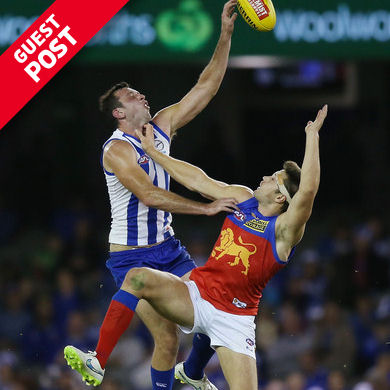
For as long as I can remember, the majority of Fantasy Coaches tend to adopt a Set and Forget approach to their Rucks. In 2016, however, we may have to get set to forget the Set and Forget format. Why? Good question and Flynny looks to answer it.
To the pleasure of all, the vest is gone in 2016. When the vest was introduced in 2011, the AFL Coaching community (the real ones) bemoaned the inability to field two rucks at once. With the AFL’s announcement that the vest was gawn (pardon the ruck pun) the real coaches were quick to rejoice the fact that they can now field two rucks again.
The question now is, what will fielding two rucks, as opposed to one dominant ruck, do to fantasy scores? My answer to that is “ruck knows” (Is that a Dean Cox pun?).
Let’s compare the ruck stats from 2010, the last non-vest season against the 2015 season:
The average number of matches across all teams played by Rucks achieving over 100 hitouts in 2010 was 38.6, compared to 30.8 in 2015. These averages are skewered slightly in 2010 with both the super mighty and awesome Dockers and lowly Melbourne having very dominant ruckman with only 21 and 22 matches respectively of rucks achieving over 100 hitouts for the year. The next lowest in 2010 was 35 by Geelong.
Completely different story for 2015 with a whopping 10 teams having less than 30 games of rucks with over 100 hitouts. So, it is fair to say that the vest dramatically increased the scoring ability of the top rucks as a result of them, generally, taking on the task themselves with little help. In 2010, two rucks split the duties between them reducing the overall number of dominant rucks.
In 2010, seven teams had over 40 matches of rucks achieving over 100 hitouts and another three on 39. This means for the most part, the majority of teams played with two rucks and they both had over 100 hitouts for the year.

In 2015, only three teams had over 40 matches of rucks achieving over 100 hitouts for the year. This means that for the most part, the majority of teams played with one dominant ruck, demonstrating that with no vest, two rucks are better than one.
Hitout numbers themselves are hard to compare between the years due to the changing nature of the game resulting in significantly increased stoppages over this six year period. An important question to answer here is, will the loss of the vest not only reduce the dominance of a single ruck, but will it also increase the speed of the game, thus reducing stoppages, creating yet another aspect of a possible global reduction in ruck scores?
So, in 2016 we have two rucks that are $100k more expensive than others with averages well over the 110 mark. But are these averages still achievable, even for the games best rucks? Well, rucked if I know.
In AF where trades are unlimited it may be wise to start with some mid-tier rucks that are on the up or have found themselves suddenly thrust into the Number One ruck role. This could include Leuey, Sinclair, Nicholls, Smith. Then let the dust settle over the first few rounds of the season, use the cash you make from these guys and upgrade to the most consistent, highest average, best job security rucks by about rounds 8 or 9 or wait it out for the byes.

As for the limited trade formats, do you really want to spend $200k on setting and forgetting with Martin and Goldy only to watch their averages drop significantly to be comparable with rucks that are $100k cheaper?
In these limited trade formats, I will be monitoring the team structures closely during the NAB and come round 1, if the likes of Trent West and Daw are lining up with Martin and Goldy, I will staying away from these two and spending my $200k in savings elsewhere.
What the ruck are you going to do?
Thank you to Flynny for dropping this fantastic piece.





















Recent Comments